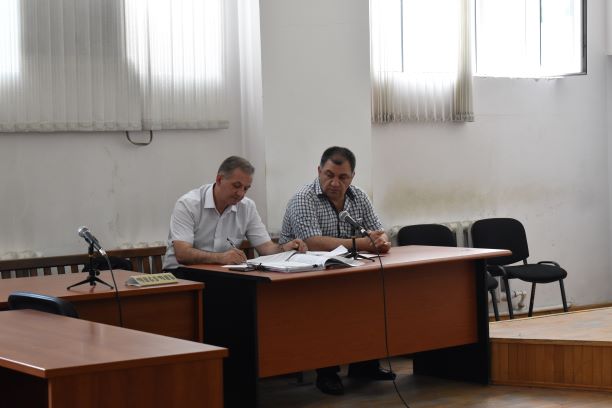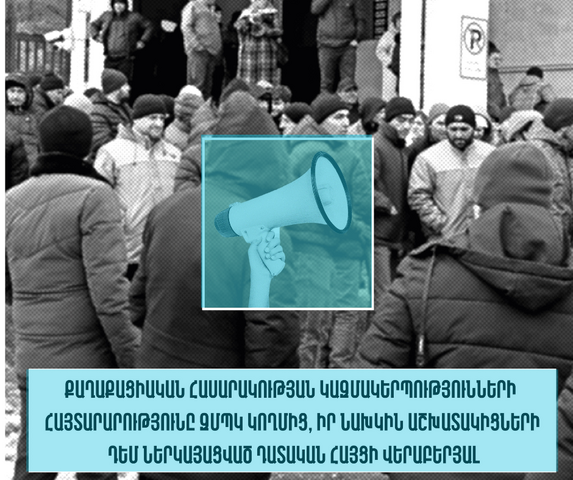Երեկ՝ 2019թ․ ապրիլի 25-ին, Լոռու մարզի ընդհանուր իրավասության դատարանում հարցաքննվեց վանաձորցի ծննդկան Հռիփսիմե Նազլուխանյանի մահվան գործով դատարան հրավիրված դատաբժիշկ-փորձագետ Հայկազն Չախոյանը, որը հանձնաժողովային դատաբժշկական փորձաքննություն իրականացրած հանձնաժողովի անդամ է։
Նա դատարան էր հրավիրվել պաշտպանական կողմի միջնորդությամբ։ Փորձագետին նախ սկսեցին հարցեր տալ պաշտպան Արտակ Ոսկանյանը և ամբաստանյալ Դավիթ Շահվերդյանը, որին մեղադրանք է առաջադրվել ՀՀ քրեական օրենսգրքի 130-րդ հոդվածի 2-րդ մասով՝ մասնագիտական պարտականությունները չկատարելու/ոչ պատշաճ կատարելու համար, որն առաջացրել է բուժվող հիվանդի մահ:
Տուժողի իրավահաջորդի շահերը ներկայացնում է Հելսինկյան քաղաքացիական ասամբլեայի Վանաձորի գրասենյակի փաստաբան Անի Չատինյանը։
Իր հարցադրումները ներկայացնելիս պաշտպան Արտակ Ոսկանյանը վկայակոչեց իր ձեռքի տակ եղած մի ձեռնարկ և պնդեց, թե Դավիթ Շահվերդյանի գործողությունները եղել են ճիշտ․ նման պայմաններում որովայնահատում ցուցված չէ։ Փորձագետն էլ հակադարձեց, որ նման տասնյակ ձեռնարկներ կան, և փորձագիտական եզրակացություն տալիս փորձագետները ևս օգտվել են դրանցից, բայց առաջնորդվել են Առողջապահության նախարարի հաստատած կլինիկական ուղեցույցով, որի համաձայն՝ Հռիփսիմե Նազլուխանյանի վիճակում որովայնահատումը այլընտրանք չի ունեցել երկու պատճառով․ այդ եղանակով հնարավոր կլիներ կամ հայտնաբերել արնահոսության աղբյուրն ու դադարեցնել արնահոսությունը, կամ հեռացնել արգանդը։ Դավիթ Շահվերդյանը դրանցից ոչ մեկը չի արել ժամեր շարունակ չդադարող արնահոսության պայմաններում, ինչի արդյունքում էլ ծննդկանը մեծ քանակությամբ արյուն է կորցրել և մահացել։
Հ․ Չախոյանը փորձագիտական եզրակացությունից մեջբերեց վերաբերելի հատվածները, ներկայացրեց կիրառված մեթոդներն ու այլ մանրամասներ։
Փորձագետին հարցեր ուղղեց նաև Դավիթ Շահվերդյանը և պնդեց, թե արգանդի պատռվածք չի եղել, հեշտոցի պատռվածքը արգանդին չէր կարող հասնել, ինչին հակադարձեց փորձագետը և կրկին մեջբերեց փորձագիտական եզրակացության այն հատվածները, որոնցով արձանագրված է, որ արգանդի վզիկի պատռվածքը հասել է մինչև արգանդի ստորին սեգմենտ, ապա վկայակոչեց ուլտրաձայնային հետազոտության արդյունքները, որոնցով արգանդում արյան մակարդուկներ են հայտնաբերվել, և ժամեր շարունակ արնահոսությունը չի դադարել։
Պաշտպանի պնդմանը, թե 60/20 զարկերակային ճնշման պայմաններում որովայնահատումը կարող էր արյան լրացուցիչ կորստի հանգեցնել, և այդ դեպքում էլ կարող էին մեղադրել դրա՛ համար, փորձագետը կրկին հաստատեց, որ շարունակական արնահոսության պայմաններում որովայնահատումը ցուցված է՝ արյան զուգահեռ փոխներարկմամբ և պետք էր օգտագործել բոլոր հնարավոր միջոցները կյանքը փրկելու համար, ոչ թե նստել ու սպասել մինչև հիվանդը արնաքամ լինի, այն դեպքում երբ արյունահոսությունը ծննդաբերությունից հետո անընդհատ եղել է:
Պաշտպանական կողմի արձանագանքին, թե արյան փոխներարկում կատարվել է, փորձագետը կրկին նշեց, որ արյան փոխներարկումը պետք է արվեր որովայնահատմանը զուգահեռ, ոչ թե՝ ինքնանպատակ․ «Արյունը ոնց մտել է, էնպես էլ դուրս է եկել, պետք էր նախ արնահոսության աղբյուրը հայտնաբերվեր, և դադարեցվեր այն»։
Փորձագետը բժշկի այլ գործողությունների ևս անդրադարձավ․ ի թիվս դրանց՝ նա հիշատակեց այն, որ բժիշկ Դավիթ Շահվերդյանը առանց անզգայացման է ձեռքով ստուգել արգանդի խոռոչը և իր զարմանքն արտահայտեց․ «Չեմ հասկանում՝ ոնց է այդ կինը այդ ցավին դիմացել»։
Պետք է արձանագրել, որ փորձագետը հիանալի տիրապետում էր գործի նյութերին, փորձագիտական եզրակացությունների մանրամասներին և բոլոր կլինիկական ուղեցույցներին և դրանում պարունակվող ցուցումներին: Փորձագետի հարցաքննությունը ևս մեկ անգամ վերահաստատեց այն վարկածը, որ ծննաբերությունից հետո Հ. Նազլուխանյանի մոտ եղած արյունահոսության պատճառը բացահայտելու, դա վերացնելու և կյանքը փրկելու ուղղությամբ Դ․ Շահվերդյանը որևէ գործուն ու արդյունավետ գործողություններ չի կատարել:
Փորձագետը նաև նշեց, որ նույնիսկ 60/20 զարկերակային ճնշման պարագայում որովայնահատումը զուգահեռ արյան ներարկումը զգալիորեն կմեծացներ կյանքը փրկելու շանսերը:
Աշխատանքային օրվա ավարտով պայմանավորված՝ դատական նիստը հետաձգվեց և նշանակվեց 2019թ․ մայիսի 17-ին։ Դատարանը կշարունակի լսել փորձագետին։
Yesterday, on April 25, 2019, in Lori region General Jurisdiction Court, Haykazn Chakhoyan (who was invited to the Court as the forensic expert doctor in the case of puerperant woman Hripsime Nazlukhanyan’s death) was interrogated. Haykazn Chakhoyan is a member of the commission that conducted forensic medical examination.
He was invited to the Court by the defendant party. First, defender Artak Voskanyan and defendant Davit Shahverdyan began asking the expert questions. An accusation had been filed against Davit Shahverdyan under Article 130 § 2 of the RA Criminal Code, i.e. failure to implement or improper implementation of professional duties which resulted in the patient’s death.
The interests of the victim’s successor are represented by Helsinki Citizens’ Assembly Vanadzor lawyer Ani Chatinyan.
While presenting his questions, defender Artak Voskanyan invoked a few handbooks at hand and claimed that Davit Shahverdyan’s actions were right and under such conditions laparotomy is not instructed. The expert, in his turn, replied that there are dozens of such handbooks and experts used them when giving an expert conclusion, but based it on the Clinical Guidelines approved by the Minister of Health, according to which in Hripsime Nazlukhanyan’s situation there was no alternative to laparotomy for two reasons –that way it would have been possible to either find the source of haemorrhage and stop it or remove the uterus. Davit Shahverdyan did neither of the above-mentioned for hours on end under the condition of continuous bleeding, as a result of which the puerperant woman lost a huge amount of blood and died.
H. Chakhoyan cited the relevant parts from the conclusion, presented the methods used and other details.
The expert was given questions by Davit Shahverdyan himself, who claimed that there was no uterine rupture, as the vagina rupture could not have reached the uterus, to which the expert counterclaimed and again cited the parts of the conclusion according to which it was recorded that the rupture of the uterine cervix had reached the lower segment of the uterus, after which he invoked the results of the ultrasound examination, which showed blood clots in the uterus and the bleeding did not stop for hours on end.
The defendant claimed that under the condition of 60/20 pulse pressure laparotomy could have led to the loss of even more blood and in that case he would have been accused for taking that measure. The expert claimed with regard to the above-mentioned that in case of continuous bleeding laparotomy is instructed with parallel transfusion of blood and that all the measures should have been taken to save the patient’s life instead of waiting for her to bleed to death, given the fact that bleeding was continuous after the delivery.
The defendant party responded that blood transfusion had been carried out, to which the expert restated that blood transfusion should have been made in parallel with laparotomy and not as the ultimate goal, “The transfused blood left the patient’s body just as it was transfused. First of all, the source of the bleeding should have been found out and bleeding should have been stopped”.
The expert touched upon other actions of the doctor, as well, among which, he stated the fact that Davit Shahverdyan checked the uterine cavity with his hand without any anesthesia, “I cannot imagine how that woman endured that pain”.
It should be recorded that the expert had properly familiarized with the case materials, details of the expert conclusions and all the clinical guidelines and the instructions therein. The interrogation of the expert reconfirmed the hypothesis according to which after H. Nazlukhanyan’s delivery, D. Shahverdyan took no effective action to find out the cause of the bleeding, eliminate it and save her life.
The expert also mentioned that even under the condition of 60/20 pulse pressure, laparotomy in parallel with blood transfusion would have significantly contributed to the chances of saving the patient’s life.
The court session was postponed due to the end of the working day and was scheduled on May 17, 2019. The Court will continue hearing the expert.
[:]




